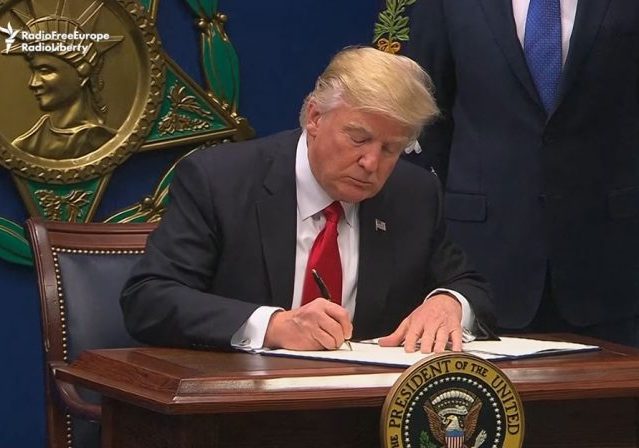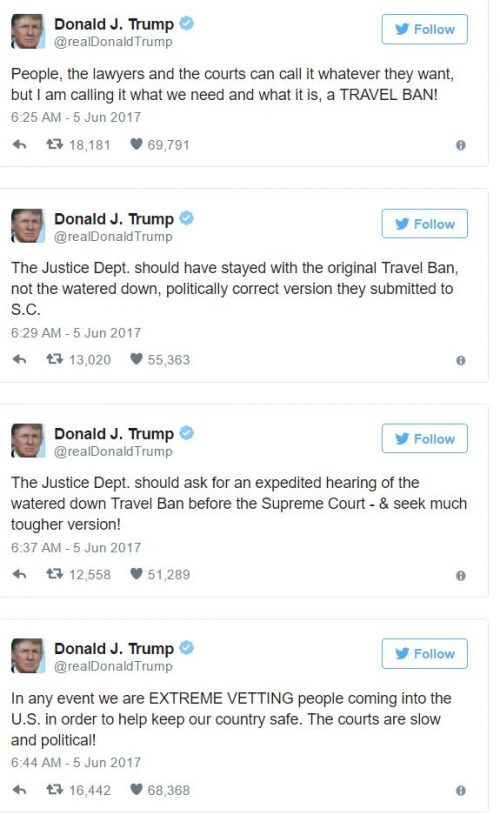Stupid travel “ban” tricks

There he went again.
Early this morning Donald Trump launched a twitter storm regarding the issue of the Executive Orders regarding visa entry to the U.S. from 6 (originally 7) majority Muslim nations previously identified by the Obama administration as posing unique security risks.
On January 28, 2017, just after the first Executive Order, I addressed much of the nonsense in the media about the substance of the Executive Order, Most claims about Trump’s visa Executive Order are false or misleading. Most significantly, it was inaccurate to describe it as a “Muslim ban,” which was the media descriptor of choice.
After numerous court losses, the Trump administration decided to fold the tent on Executive Order No. 1, and issue a watered-down version intended to mollify judicial hostility rather than taking the case to the Supreme Court. I thought that was a grievous error, President Trump must not back down on immigration Executive Order:
I have seen many analyses critical of the 9th Circuit ruling which urge the Trump administration to take a step back, to withdraw the current Executive Order and rewrite it to fit what is acceptable to the 9th Circuit. The Trump administration, according to some reports, is considering doing that.That would be a grievous mistake.The Executive Order, as the Trump administration has said it would be enforced (for example, excluding green card holders from its reach), is perfectly lawful and within the President’s power and authority. To accept the 9th Circuit ruling is to accept that the President does not have the powers vested in him by the Constitution and Congress.This legal dispute no longer is just about the Executive Order. Democrats have made clear that they will fight in court over almost everything the Trump administration does. The 9th Circuit has opened the door to this tactic on an issue that goes to the core of presidential authority.If the Courts are to designate themselves the functional directors of the Department of Homeland Security, then such mandate must come from the Supreme Court, not the 9th Circuit.
We’re now at the Supreme Court, on Order No. 2, after patently absurd reliance by the 4th Circuit on Trump’s campaign statements. It is anticipated that this month the Supreme Court will rule both on Trump’s request to take the case, and his request to reinstate Order No. 2 pending hearing of the case.
Which brings me back to Trump’s tweet storm. He tweeted not only that there was nothing wrong with calling it a “ban,” but also that he regretted abandoning the original order.
Whether Trump calls it a “ban” or not is legally meaningless, just as Trump not calling it a ban also would have been legally meaningless. The travel order is what it is. There’s a reality that does not depend on how politicians, media, pundits, or social media users (or even blog commenters!) characterize it.
And the reality is that it’s not a “ban” on travel. The people who are abroad with no legal right to enter the U.S. can travel, just not here. Only if we consider that open borders is a right could controlling our border entry be deemed a travel ban.
So why are people making such a big deal about the use of the term “ban”? Because they are, deliberately in some cases, ignorantly in others, eliding “Muslim Ban” with “Travel Ban.”
That’s what the ACLU did:
That’s what Chris Cuomo did in this particularly dumb hot take on CNN:
Northwestern Law Professor Eugene Kontorovich pointed out the distinction Cuomo missed, the legal issue never was whether it was a “ban,” but what type of “ban”:
Law Professor Josh Blackman, while finding the tweets unwise, also finds the terminology in dispute legally irrelevant:
Finally, much ado has been made today about the fact that he called it a “travel ban” and referred to the current version as “watered down.” This is not new language from Trump. The plaintiffs have read his previous reference to the “watered down” order to refer back to his original promise on the campaign trail to ban all Muslims, but for reasons I discuss in Part I of my series on IRAP v. Trump, this is not a plausible construction of his entire remarks from that speech.That said, Trump’s use of the word “ban” raises questions. During a January 31 press conference, a reporter asked Sean Spicer about the President referring to it as a “ban.” Spicer denied that it was a ban, citing Homeland Security Secretary Kelly’s statement to the contrary. It is remarkable that the President’s own cabinet cannot get on the same page as the President. Why did Trump call it that? “He’s using the words that the media is using,” Spicer replied. The reporter followed up “It’s his words, his tweet.” Spicer replied, “I think that the words that are being used to describe it are derived from what the media is calling this. He has been very clear that it is extreme vetting.” This phrase, “extreme vetting,” is also how Trump described the order in his final tweet this morning.What does all of this mean for the Supreme Court’s resolution of IRAP v. Trump? Under Kerry v. Din and Kleindienst v. Mandel, the Court’s review for legitimacy and bona fides is limited to the four corners of the policy. If the Justices abide by those precedents, none of these statements will be relevant.
Kontorovich goes as step farther, and argues Trump’s travel tweets do not hurt the legal case for his executive orders:
Trump’s tweets were certainly Trumpian in tone, and the criticism of his own Justice Department for submitting an executive order he signed does not make him look good. But there is nothing in these tweets that should weaken the Solicitor General’s case before the Supreme Court, or that supports the view that the policies were unconstitutional because of an impermissible motive on the president’s part….Commentators are reacting as if Trump said that the revised version is a “watered down” Muslim ban. He did not. He said it is a watered down version of the first order, which everyone already knew….Finally, the tweets may actually bolster the government’s legal case (rather than purposefully undermine it, as Jack Goldsmith suggested). The tweets imply that Trump had little or no role in the drafting of the current executive order — the Justice Department is responsible. If we accept that, then any animus that may infect him would not attach to the order of which he is not the author, unless one is to say the administration is generally disabled from carrying out non-permissive immigration policies with respect to a quarter of the world’s nations. And if one does not take his statement that the Justice Department is responsible for the order to mean the most it can mean, how can one read his campaign statements for their maximal, and worst, possible meaning?
So, assuming the Justices focus on the legal issue, which is the president’s authority and the extraordinarily narrow judicial review, Trump’s characterization of the Order as a “ban” should have no impact.
But there’s another point, which is not really a legal point. The Justices certainly are aware of the firestorm kicked off by the tweets. We know that Ruth Bader Ginsburg already has a dim view of Trump’s credibility and style, as I wrote in How can Ginsburg participate in Travel Order case after her *campaign* statements about Trump?
The tweets appear to be taunting the Supreme Court, as George Conway (Kellyanne’s husband, who at one time was under consideration for Solicitor General) noted:
So no, I don’t think these tweets help Trump. I agree that Trump would be an impossible client to represent for this very reason. But perhaps he understands that this is not just a court fight, it’s a public opinion fight and he already knows how the media and punditry vote. They are not his audience.
On the legal front, the question is whether the Supreme Court Justices will take a personal view of this case, as have lower courts, or understand the enormous implications of the Courts taking on national security and immigration powers reserved for the President.
If the Supreme Court takes a sober view of this situation, Trump’s tweets and characterization of the travel order will have been just another media dust-up. But that’s a big “IF”.
CLICK HERE FOR FULL VERSION OF THIS STORY
